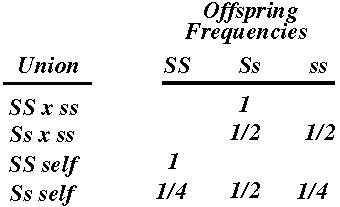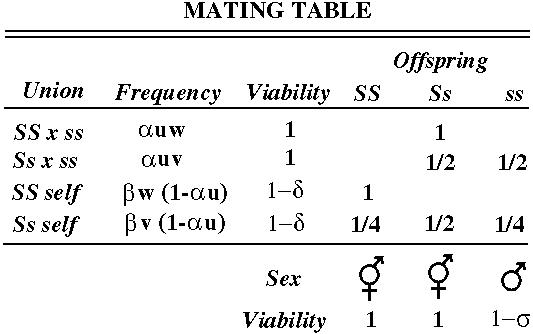
Evolution with three sexes



Eulimnadia texana is an extremely unusual species in having three sexes (at least genetically). Sex in Eulimnadia is determined by a gene or gene region as follows:
Female Female Male
Females reproduce by one of two means: self-fertilization and/or sex with males. Males cannot self and females cannot fertilize one another.
Consequently, the following matings can occur:

Interestingly, the sex ratio varies from pool to pool, with males ranging from 0-35%.
A number of evolutionary questions arise in this system:




Parameter: "An arbitrary constant whose value describes a characteristic of a system"
 : fitness of males relative to fitness of females
: fitness of males relative to fitness of females
 : fitness of individuals produced by selfing
: fitness of individuals produced by selfing
 : proportion of eggs that will be mated with male sperm when a male is encountered
: proportion of eggs that will be mated with male sperm when a male is encountered
 : proportion of eggs not fertilized by males that are selfed
: proportion of eggs not fertilized by males that are selfed
 (the probability of encountering a male times the probability of using his sperm).
(the probability of encountering a male times the probability of using his sperm).




 is the average fitness and equals the sum of the numerators. We must divide by the average fitness so that u', v' and w' remain frequency measures that sum to one.
is the average fitness and equals the sum of the numerators. We must divide by the average fitness so that u', v' and w' remain frequency measures that sum to one.


At equilibrium u'=u, v'=v, and w'=w. This gives us three equations in three unknowns (u, v, w).
Solving these three equations indicates that there are only two biologically interesting equilibrium states.
 No males, No outcrossing
No males, No outcrossing

 Males present
Males present
Analysis Step 2: Determine which equilibria are stable
The w=1 equilibrium is the only stable equilibrium when  . When this condition fails to hold, the population will converge towards the second equilibrium with males present.
. When this condition fails to hold, the population will converge towards the second equilibrium with males present.
Therefore males will be maintained in the population if they are fairly fecund ( high) and fairly viable (1-
high) and fairly viable (1- high), if females are poorly able to fertilize their own eggs (
high), if females are poorly able to fertilize their own eggs ( low), and if there is substantial inbreeding depression (1-
low), and if there is substantial inbreeding depression (1- low).
low).
Notice that if there are no viability differences ( =
=  = 0), males will only be maintained if
= 0), males will only be maintained if  > 2
> 2  . This reflects a phenomenon known as the "two-fold cost of sex".
. This reflects a phenomenon known as the "two-fold cost of sex".


Using these proportions, we estimate that males must have a lower fitness, being approximately 58% as viable as females. Furthermore,  must be about an order of magnitude higher than
must be about an order of magnitude higher than  (1-
(1- ) in order to be consistent with the composition of this population.
) in order to be consistent with the composition of this population.
 When males are encountered, most eggs must be fertilized with male sperm or most eggs must die when they are self-fertilized.
When males are encountered, most eggs must be fertilized with male sperm or most eggs must die when they are self-fertilized.
This analysis is being used by Stephen Weeks to gain further insight into the factors that allow the maintenance of sexual reproduction in this shrimp.